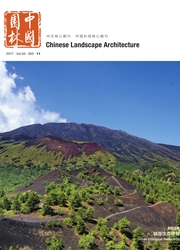

 中文摘要:
中文摘要:
住区风景园林空间是城市人群出行活动的重要场所之一,使用者对微气候的感受直接影响其空间使用的频次和整体体验。以3个上海中心城区的住宅小区为实验对象,运用现场实测的方法,在广场、滨水、亭廊和庭园4类风景园林空间内进行了为期9天的冬季测试。研究运用生理等效温度(PET)指标进行风景园林空间人体感受的量化计算,对人体在微气候(即热、风、湿因子)环境内的理论感受结果进行回归分析。结果显示热因子是影响冬季人体感受的最关键因子,其中微气候子因子太阳辐射是影响人体舒适感受的根源。各实验空间中,广场区的理论体感最佳,亭廊区其次,这2类空间共有的微气候特征为:太阳辐射强、空气温度高、相对湿度较低、风力微弱且不持续。实验证明大面积开敞硬地形成的热量场、匀质的立面围合形式和开敞的顶面可满足上海冬季体感舒适要求。结论中对风景园林空间顶面、立面、底面的建议可作为住区风景园林空间冬季微气候适宜性设计的参考。
 英文摘要:
英文摘要:
Landscape space in residence is one of the most frequent using places for urban population,in which micro-climate affects theexperiences of space using and active frequency directly.In this study,field measurements of three residential areas in winter within fourlandscape spaces including plaza,waterfront,pavilion and corridor,and garden are carried out,to investigate the effect of landscape structureon micro-climate environment(which includes thermal,windy and humidity factors)and further on human perception.The experimental resultsshow that radiant heat is the key factor affecting the human perception in winter,in which the solar radiation factor is the root cause of the changeof micro-climatic perception;the effect of relative humidity and air flow come next.In the test residences,the plaza area has the best perceptionassessment,followed by the pavilion and corridor space.The common micro-climatic characteristics of the two spaces are:sufficient solarradiation,high air temperature;low humidity;gentle breezing and discontinuous wind,which proves that the large open hard ground can promoteheat gathered and properly ventilated to meet the winter comfort requirements of human body.According to the analysis,for the top,vertical,bottom of the space respectively,light,air vent and green area can be used to simply assess the human experience.And Physiological EquivalentTemperature(PET)as human comfort index is based on these three main variables.The method of space structure can be used as a guideline forthe designing of micro-climate suitability in residential landscapes.
 同期刊论文项目
同期刊论文项目
 同项目期刊论文
同项目期刊论文
 期刊信息
期刊信息
